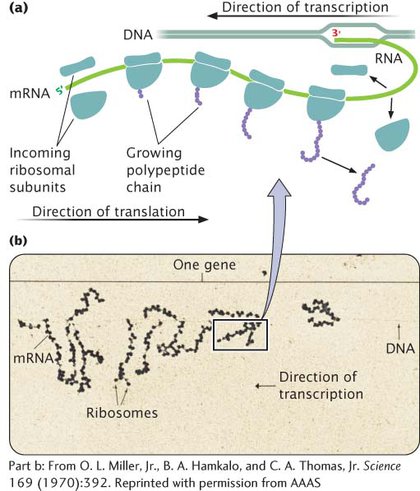In both prokaryotic and eukaryotic cells, mRNA molecules are translated simultaneously by multiple ribosomes (Figure 11.14). The resulting structure—an mRNA with several ribosomes attached—is called a polyribosome (or often just a polysome). Each ribosome successively attaches to the ribosome-binding site at the 5′ end of the mRNA and moves toward the 3′ end; the polypeptide associated with each ribosome becomes progressively longer as the ribosome moves along the mRNA. In prokaryotic cells, transcription and translation are simultaneous; multiple ribosomes may be attached to the 5′ end of the mRNA while transcription is still taking place at the 3′ end, as shown in Figure 11.14. In eukaryotes, transcription and translation are separated in time and space: transcription takes place in the nucleus and translation takes place in the cytoplasm.

11.14 An mRNA molecule may be translated simultaneously by several ribosomes. (a) Four ribosomes are translating an mRNA molecule; the ribosomes are depicted as moving from the 5′ end to the 3′ end of the mRNA. (b) In this electron micrograph, the long horizontal filament is DNA, the dark-staining spheres are polyribosomes, and the thin filaments connecting the ribosomes are mRNAs. Transcription of the DNA is proceeding from right to left; the mRNAs on the right are shorter than those on the left. Each mRNA is being translated by multiple ribosomes.
[Part b: From O. L. Miller, Jr., B. A. Hamkalo, and C. A. Thomas, Jr. Science 169 (1970):392. Reprinted with permission from AAAS.]

 CONCEPT CHECK 7
CONCEPT CHECK 7